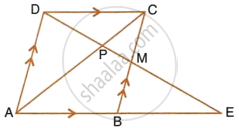Advertisements
Advertisements
Question
In the following figure, M is mid-point of BC of a parallelogram ABCD. DM intersects the diagonal AC at P and AB produced at E. Prove that : PE = 2 PD

Solution
In ΔBME and ΔDMC,
∠BME = ∠CMD ...(Vertically opposite angles)
∠MCD = ∠MBE ...(Alternate angles)
BM = MC ...(M is the mid-point of BC)
So, ΔBME ≅ ΔDMC ...(AAS congruence criterion)
`=>` BE = DC = AB
In ΔDCP and ΔEPA,
∠DPC = ∠EPA ...(Vertically opposite angles)
∠CDP = ∠AEP ...(Alternate angles)
ΔDCP ∼ ΔEAP ...(AA criterion for similarity)
`=> (DC)/(EA) = (PC)/(PA) = (PD)/(PE)`
`=> (EA)/(DC) = (PE)/(PD)`
`=> (PE)/(PD) = (AB + BE)/(DC)`
`=> (PE)/(PD) = (2DC)/(DC)`
`=> (PE)/(PD) = 2`
`=>` PE = 2PD
APPEARS IN
RELATED QUESTIONS
Prove that the line segments joining the mid points of the sides of a triangle form four triangles, each of which is similar to the original triangle
Show that ΔABC, where A(–2, 0), B(2, 0), C(0, 2) and ΔPQR where P(–4, 0), Q(4, 0), R(0, 2) are similar triangles
In the given figure, BC is parallel to DE. Area of triangle ABC = 25 cm2, Area of trapezium BCED = 24 cm2 and DE = 14 cm. Calculate the length of BC. Also, find the area of triangle BCD.

The perimeter of two similar triangles ABC and PQR are 32cm and 24cm respectively. If PQ = 12cm, find AB.
In the given figure, ABC is a triangle and PQ is a straight line meeting AB in P and AC in Q. If AP = 1cm, PB = 3cm, AQ = 1.5cm, QC = 4.5cm, prove that area of ΔAPQ is 116 of the area of ΔABC.
ΔABC ∼ ΔDEF and A(ΔABC) : A Δ(DEF) = 1 : 2 If AB = 4 find DE.
A triangle ABC is enlarged, about the point O as centre of enlargement, and the scale factor is 3. Find : A' B', if AB = 4 cm.
If ΔABC ~ ΔDEF, then writes the corresponding congruent angles and also write the ratio of corresponding sides.
Which of the following is not a test of similarity?
Areas of two similar triangles are equal then prove that triangles are congruent
